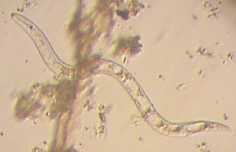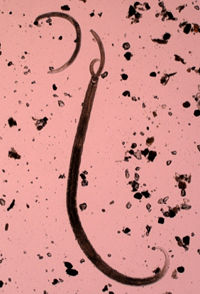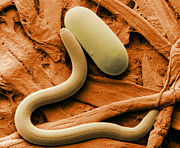Nematode
| Nematodes | ||||||||
|---|---|---|---|---|---|---|---|---|
 Unidentified roundworm from wet soil.
The mouth is at the top left corner. |
||||||||
| Scientific classification | ||||||||
|
||||||||
| Classes | ||||||||
|
"Adenophorea" (paraphyletic?) |
||||||||
| Synonyms | ||||||||
|
Nemata Cobb, 1919 |
The roundworms or nematodes (phylum Nematoda) are the most diverse phylum of pseudocoelomates, and one of the most diverse of all animals. Nematode species are very difficult to distinguish; over 80,000 have been described, of which over 15,000 are parasitic. It has been estimated that the total number of described and undescribed roundworms might be more than 500,000.
Nematodes have successfully adapted to nearly every ecological niche from marine to fresh water, from the polar regions to the tropics, as well as the highest to the lowest of elevations. They are ubiquitous in freshwater, marine, and terrestrial environments, where they often outnumber other animals in both individual and species counts, and are found in locations as diverse as Antarctica and oceanic trenches. They represent, for example, 90% of all life on the seafloor of the Earth[1]. The many parasitic forms include pathogens in most plants, animals, and also in humans. Some nematodes can undergo cryptobiosis. Hundreds of Caenorhabditis elegans, featured in a research project on mission STS-107, survived the Space Shuttle Columbia Disaster.[2]
Contents |
Taxonomy and systematics
The name "Nematoda" means "the thread-like ones", from Ancient Greek νῆμα (nema, "thread") and -ώδη (-ode, "like"). The group was originally established by Karl Rudolphi in 1808 under the name Nematoidea, but reclassified as family Nematodes by Burmeister in 1837. They were eventually renamed Nematoda by K. M. Diesing in 1861. Nathan Cobb in 1919 argued that they should be called Nemata or Nemates, and in English "nemas" rather than "nematodes", but Diesing's revision has stuck.
After some confusion which saw the nematodes placed – often together with the horsehair worms (Nematomorpha) – as a class or order (e.g. independently by Leuckart and von Siebold in 1848) in various groups such as the Aschelminthes, Ray Lankester in 1877 finally promoted them to the rank of phylum. This was done to acknowledge the fact that roundworms are not part of another group of "worms", but represent a unique and highly distinct lineage.
Phylogeny

Whether they are relatives of the nematodes is still unknown.
The relationships of the nematodes and their close relatives among the protostomian Metazoa are unresolved. Traditionally, they were held to be a lineage of their own, but in the 1990s it was proposed that they form a clade together with moulting animals such as arthropods. This group has been named Ecdysozoa. However, the monophyly of the Ecdysozoa was never unequivocally accepted: while most researchers however consider at least the placement of arthropods as more distant relatives of annelids – with which they were formerly united – to be warranted, the presumed close relationships of the nematodes and relatives with the arthropods has been a major point of contention.[3]
Even though the amount of data since accumulated in regard to this problem is staggering, the situation seems if anything less clear these days. DNA sequence data, initially strongly supporting the Ecdysozoa hypothesis, has become rather equivocal on ecdysozoan monophyly, and is simply unable to refute either a close or a more distant relationship between the arthropod and nematode lineages. That the roundworms have a large number of peculiar apomorphies and in many cases a parasitic lifestyle confounds morphological analyses. Genetic analyses of roundworms suggest that – as is also indicated by their unique morphological features – the group has been under intense selective pressure during its early radiation, resulting apparently in accelerated rates of both morphological and molecular evolution. Furthermore, no distinctive apomorphies of Ecdysozoa are known; even moulting has recently been confirmed to occur outside the presumed clade.[3]
Conversely, the identity of the closest living relatives of the Nematoda has always been well-resolved. Morphological characters and molecular phylogenies agree with placement of the roundworms as sister taxon to the parasitic horsehair worms (Nematomorpha); together they make up the Nematoida. Together with the Scalidophora (formerly Cephalorhyncha), the Nematoida form the Introverta. It is entirely unclear whether the Introverta are, in turn, the closest living relatives of the enigmatic Gastrotricha; if so, they are considered a clade Cycloneuralia, but there is much disagreement both between and among the available morphological and molecular data. The Cycloneuralia or the Introverta – depending on the validity of the former – are often ranked as a superphylum.[3]
Nematode systematics
Due to the lack of knowledge regarding many nematodes, their systematics is contentious. Traditionally, they are divided into two classes, the Adenophorea and the Secernentea; as it seems, the latter are indeed a natural group of closest relatives. But the "Adenophorea" appear to be a paraphyletic assemblage of roundworms simply retaining a good number of ancestral traits; the Enoplia do not seem to be monophyletic either but to contain two distinct lineages. The "Chromadoria" seem to be another paraphyletic assemblage, with the Monhysterida representing a very ancient minor group of nematodes. Among the Secernentea, the Diplogasteria may need to be united with the Rhabditia. while the Tylenchia might be paraphyletic with the Rhabditia.[4]
Thus, the current understanding of roundworm systematics and phylogeny can be expressed as follows:
PHYLUM NEMATODA
- Basal order Monhysterida
- Basal subclass/Class Enoplia
- Basal subclass/Class Dorylaimia
- Class Secernentea
- Subclass Diplogasteria (disputed)
- Subclass Rhabditia (paraphyletic?)
- Subclass Spiruria
- Subclass Tylenchia (disputed)
- "Chromadoria" assemblage
There are a number of genuses of nematodes including the genus Megalobatrachonema.
Morphology

Roundworms are unsegmented, bilaterally symmetric and triploblastic protostomes with a complete digestive system. They have no circulatory or respiratory systems so they use diffusion to breathe[5].
Although they lack a circulatory system, nutrients are transported throughout the body via fluid in the pseudocoelom. They are thin and are round in cross section. Nematodes are one of the simplest animal groups to have a complete digestive system, with separate orifices for food intake and waste excretion, a pattern followed by all subsequent, more complex animals. The body cavity is a pseudocoelom (persistent blastula), which lacks the muscles of coelomate animals that protects the body from drying out, from digestive juices, or from other harsh environments. Although this cuticle allows movement and shape changes via a hydrostatic skeletal system, it is very inelastic so does not allow the volume of the worm to increase. Therefore, as the worm grows, it has to molt and form new cuticles. The cuticles don't allow volume to increase so as to keep hydrostatic pressure inside the organism very high. For this reason, the roundworms do not possess circular muscles (just longitudinal ones) as they're not required. This hydrostatic pressure is the reason the roundworms are round.
Nematodes have a simple nervous system, with a main ventral nerve cord and a smaller dorsal nerve cord[6]. Sensory structures at the anterior end are called amphids, while sensory structures at the posterior end are called phasmids. There are no circular muscles, so the body can only undulate from side to side. Contact with solid objects is necessary for locomotion; its thrashing motions vary from mostly to completely ineffective at swimming.
Most free-living nematodes are microscopic, though a few parasitic forms can grow to over a meter in length (typically as parasites of very large animals such as whales). The largest nematode species ever recorded, Placentonema gigantissima, was discovered parasitizing the placenta of a Sperm Whale (Physeter catodon). It was found to measure 8.5 m in length, with a diameter of 0.3 mm and containing 32 ovaries. Other large nematodes include the Giant Kidney Worm (Dioctophyma renale), a parasite most commonly found in minks (Mustela spp.), but also in dogs and humans, that can reach up to 103 cm in length.[7]
Nematodes generally eat bacteria, fungi and protozoans, although some are filter feeders. Excretion happens through a separate excretory pore. Nematodes also contract bacterial infections within excretion pores.
Reproduction
Reproduction is usually sexual. Males are usually smaller than females (often much smaller) and often have a characteristically bent tail for holding the female for copulation. During copulation, one or more chitinized spicules move out of the cloaca and are inserted into genital pore of the female. Amoeboid sperm crawl along the spicule into the female worm. Nematode sperm is thought to be the only eukaryotic cell without the globular protein G-actin.
Eggs may be embryonated or unembryonated when passed by the female, meaning that their fertilized eggs may not yet be developed. In free-living roundworms, the eggs hatch into larva, which eventually grow into adults; in parasitic roundworms, the life cycle is often much more complicated.
Nematodes as a whole possess a wide range of modes of reproduction[8]. Some nematodes, specifically Heterorhabditis spp., undergo a process called endotokia matricida: intrauterine birth causing maternal death[9] Some nematodes, like other animals (for example segmented worms), are hermaphroditic. The hermaphroditic nematode keeps its self-fertilized eggs inside its uterus until they hatch. The juvenile nematodes will then ingest the parent nematode. This process is significantly promoted in environments with a low or reducing food supply[9]. The nematode model species Caenorhabditis elegans and C. briggsae exhibit androdioecy, which is very rare amongst animals. The single genus Meloidogyne (root-knot nematodes) exhibit a range of reproductive modes including sexuality (amphimixis), facultative sexuality, meiotic parthenogenesis (automixis) and mitotic parthenogenesis (apomixis).
Free-living species
In free-living species, development usually consists of four molts of the cuticle during growth. Different species feed on materials as varied as algae, fungi, small animals, fecal matter, dead organisms and living tissues. Free-living marine nematodes are important and abundant members of the meiobenthos. They play an important role in the decomposition process, aid in recycling of nutrients in marine environments and are sensitive to changes in the environment caused by pollution. One roundworm of note is Caenorhabditis elegans, which lives in the soil and has found much use as a model organism. C. elegans has had its entire genome sequenced, as well as the developmental fate of every cell determined, and every neuron mapped.
Parasitic species
Nematodes commonly parasitic on humans include ascarids (Ascaris), filarids, hookworms, pinworms (Enterobius) and whipworms (Trichuris trichiura). The species Trichinella spiralis, commonly known as the trichina worm, occurs in rats, pigs, and humans, and is responsible for the disease trichinosis. Baylisascaris usually infests wild animals but can be deadly to humans as well. Haemonchus contortus is one of the most abundant infectious agents in sheep around the world, causing great economic damage to sheep farms. In contrast, entomopathogenic nematodes parasitize insects and are considered by humans to be beneficial.
One form of nematode is entirely dependent upon the wasps which are the sole source of fig fertilization. They prey upon the wasps, riding them from the ripe fig of the wasp's birth to the fig flower of its death, where they kill the wasp, and their offspring await the birth of the next generation of wasps as the fig ripens.

Plant parasitic nematodes include several groups causing severe crop losses. The most common genera are Aphelenchoides (foliar nematodes), Ditylenchus, Globodera (potato cyst nematodes), Heterodera (soybean cyst nematodes), Longidorus, Meloidogyne (root-knot nematodes), Nacobbus, Pratylenchus (lesion nematodes), Trichodorus and Xiphinema (dagger nematodes). Several phytoparasitic nematode species cause histological damages to roots, including the formation of visible galls (e.g. by root-knot nematodes) which are useful characters for their diagnostic in the field. Some nematode species transmit plant viruses through their feeding activity on roots. One of them is Xiphinema index, vector of GFLV (Grapevine Fanleaf Virus), an important disease of grapes.
Other nematodes attack bark and forest trees. The most important representative of this group is Bursaphelenchus xylophilus, the pine wood nematode, present in Asia and America and recently discovered in Europe.
Nematodes in agriculture
Depending on the species, a nematode may be beneficial or detrimental to plant health.
From an agricultural perspective, there are two categories of nematode: predatory ones, which will kill garden pests like cutworms, and pest nematodes, like the root-knot nematode, which attack plants.
Predatory nematodes can be bred by soaking a specific recipe of leaves and other detritus in water, in a dark, cool place, and can even be purchased as an organic form of pest control.
Rotations of plants with nematode resistant species or varieties is one means of managing parasitic nematode infestations. Another is treatment with natural antagonists such as the fungus gliocladium roseum.
See also
- Ascariasis: A human disease caused by the parasitic roundworm Ascaris lumbricoides
- Caenorhabditis elegans: An important model organism often used to study cellular differentiation, sometimes simply referred to as "worm" by scientists.
- List of parasites (human)
- Toxocariasis: A helminth infection of humans caused by the dog or cat roundworm, Toxocara canis or Toxocara cati
Footnotes
References
- Atkinson, H.J. (1973): The Respiratory Physiology of the Marine Nematodes Enoplus brevis (Bastian) and E. communis (Bastian): I. The Influence of Oxygen Tension and Body Size. J. Exp. Biol. 59(1): 255-266. PDF fulltext
- BBC News (2003): Worms survived Columbia disaster. Version of 2003-MAY-01. Retrieved 2008-NOV-04.
- Bell, G (1982): The Masterpiece of Nature: The Evolution and Genetics of Sexuality. University of California Press
- Genova, Cathleen (2007): Deep-sea species' loss could lead to oceans' collapse, study suggests. Version of 2007-DEC-27. Retrieved 2008-NOV-04.
- Gubanov, N.M. (1951): "Giant nematoda from the placenta of Cetacea; Placentonema gigantissima nov. gen., nov. sp.". Proc. USSR Acad. Sci. 77(6): 1123-1125 [in Russian].
- Johnigk, Stefan-Andreas & Ehlers, Ralf-Udo (1999): Endotokia matricida in hermaphrodites of Heterorhabditis spp. and the effect of the food supply. Nematology 1(7-8): 717–726. doi:10.1163/156854199508748 (HTML abstract)
- Merck Veterinary Manual (MVM) (2006): Giant Kidney Worm Infection in Mink and Dogs. Retrieved 2007-FEB-10.
- Tree of Life Web Project (ToL) (2002a): Bilateria. Version of 2002-JAN-01. Retrieved 2008-NOV-02.
- Tree of Life Web Project (ToL) (2002b): Nematoda. Version of 2002-JAN-01. Retrieved 2008-NOV-02.
- White, J.G.; Southgate, Eileen; Thomson, J.n. & Brenner, S. (1976)): The Structure of the Ventral Nerve Cord of Caenorhabditis elegans. Phil. Trans. Roy. Soc. B 275(938): 327-348. PDF fulltext
External links
- http://www.ucmp.berkeley.edu/phyla/ecdysozoa/nematoda.html
- Nematode.net: Repository of parasitic nematode sequences.
- http://www.nematodes.org/
- NeMys World free-living Marine Nematodes database
- Nematode Virtual Library
- International Federation of Nematology Societies
- Society of Nematologists
- Australasian Association of Nematologists
- Research on nematodes and longevity
on the UF / IFAS Featured Creatures Web site
- soil nematodes
- Illustrated Key to the Genera of Free-living Marine Nematodes in the Superfamily Chromadoroidea
- Belonolaimus longicaudatus, a sting nematode
- Bursaphelenchus cocophilus, red ring nematode
- Dolichodorus spp., awl nematodes
- Hoplolaimus galeatus, lance nematode
- Paratrichodorus minor, a stubby-root nematode
- Rotylenchulus reniformis, reniform nematode
- Steinernema scapterisci, mole cricket nematode
- Trichodorus obtusus, a stubby-root nematode